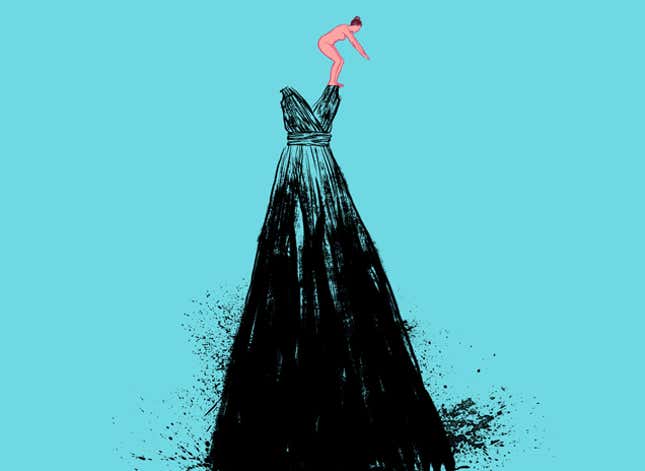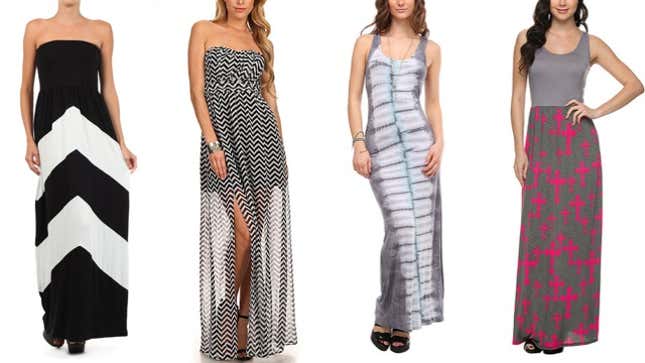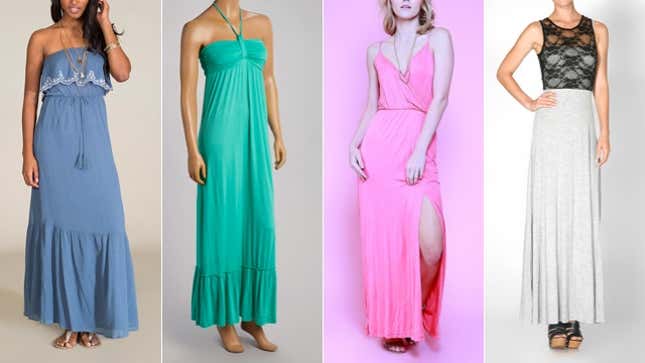Death to the Maxi Dress: A Manifesto
Latest

The first time I remember being aware of the maxi dress was about five years ago, when I was on a trip to New York and found myself standing in line at an Upper East Side bagel store behind a woman wearing one. It was blue and white striped, and fitted over her large breasts, but the rest of it was an alternately flowing and clinging tent. She asked for her bagel scooped out—duh—and also bought a Diet Coke. She was texting with two thumbs, and her toes were newly painted tangerine orange, and I know this because her toes were the sole evidence that her body did in fact possess a lower half. I remember thinking about the timeless Sylvia Plath line “cow-heavy in my Victorian nightgown” and how “cow-heavy in my enormous fucking dress” just didn’t have the same ring to it.
For the rest of the time I was in New York, I saw more and more of these dresses. They were often worn by a certain type of woman, aged 25 to 35, generally busty, generally working out some kind of tense negotiation between prettiness and being angry about something their phone told them. I’ll put it this way: During that whole visit, whenever I saw a woman wearing a maxi dress, I made a mental note: “Never ever find yourself on a Saturday morning standing in between this woman and the entrance to her neighborhood Drybar.”
I was just about to develop the opinion that women with large breasts should not wear maxi dresses when, soon after, back in California, I saw a very tall flat-chested woman wearing a maxi dress. The dress exposed at least some of her ankles, making me marginally less tempted to inquire if she wanted someone to tuck her in and read her Goodnight, Gorilla. But, even though she was a real knockout—and, despite my tone here, the bagel shop woman was as well—the dress was far from flattering. In some ways it almost looked worse on her than it had on the shorter, bustier woman. You see, it is quite an effort to be tall. It is hard to cart around so much self. So when you add miles and miles of fabric, the fabric is a barometer of the strain it takes to move your form through space. You strain, and the fabric strains with you.
My point is: Maxi dresses look bad on everyone.

I wish the story of maxi dresses could be found in fossil records. Alas, I had better luck with an informative, albeit slightly triggering blog post entitled “Mini History of the Maxi Dress.” Writing in the summer of 2008—potential dissertation title: Double Bubble: The Housing Crisis and the Matching Fashion Crisis That Followed!—fashion historian Heather Vaughan opened up the conversation by observing she saw a lot of women at that year’s San Francisco Jazz Festival sporting “the new summer hit.” (Pause to imagine these three awful things, i.e. jazz, maxi dresses, San Francisco, all in one place.) Vaughan guesses the first modern maxi dress was a white lacy Oscar de la Renta number that appeared in 1968. Other designers—YSL, Dior and Halston among them—followed suit. The maxi dress became extremely popular at the beginning of the ‘70s and was gone by the end of them. Gone, but not forgotten.
I have dim memories of my mom and some of her friends in maxi dresses in the ‘70s and thinking they were pretty nice. Granted, my mother was not gifted/cursed with the enormous breasts I have which have ensured that I have never owned one, because, truly: as bad as maxi dresses look on everyone, they are absolutely the worst on my body type, which is tall and busty. If you are tall and have a big rack and you’re thinking about getting a maxi dress, find me on Twitter and I will actually take time out of sipping nettle tea and rearranging my collection of flattering fit-and-flare dresses to talk you out of it.

Now, I am not the only person who thinks maxi dresses are ugly. The internet is littered with maxi dress bafflement. A bad one can make even Poppy Delevingne or the Jenner sisters appear on worst-dressed lists. There are many like-minded folks on Twitter, expressing relatable sentiments such as:

Sadly, the return of warm weather every year brings the return of the maxi dress. You can still go to any big department store—or any online retailer—and look for maxi dresses, and find them. Famous fancy designers like Ann Demeulemeester are still putting maxi dresses on the runway. Pinterest is a veritable minefield of maxi dresses. (I am not showing any more maxi dress photos or linking to anything else because that would just be giving the maxi dress people what they want.)
It’s one thing that maxi dresses won’t go away, but what’s even sadder was that I had no luck finding a fashion expert who would just agree with me. Granted, a bunch of people—people like Tim Gunn—didn’t get back to me. I also sent my questions—essentially variations on a theme of “Why do people still wear maxi dresses?” “Don’t people know how ugly maxi dresses are?” and “Can nothing be done?”—to an agent who represents stylists, but he kept asking me who I was, and after a while, I honestly had no idea. Fran Lebowitz’s agent couldn’t have been nicer but she told me I would have to send Lebowitz a letter. I wrote back, “Okay, but first I have to find a place that sells pens,” and that was the end of that.
-

-

-

-

-

-

-

-

-

-

-

-

-

-

-

-

-

-

-

-

-

-

-

-

-

-

-

-

-

-

-

-

-

-

-

-

-

-

-

-









































